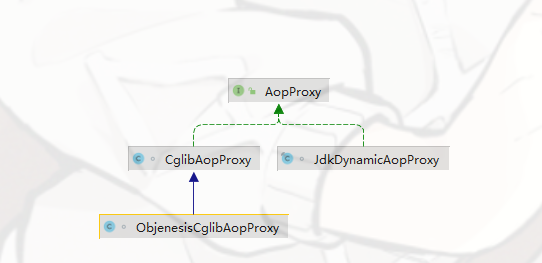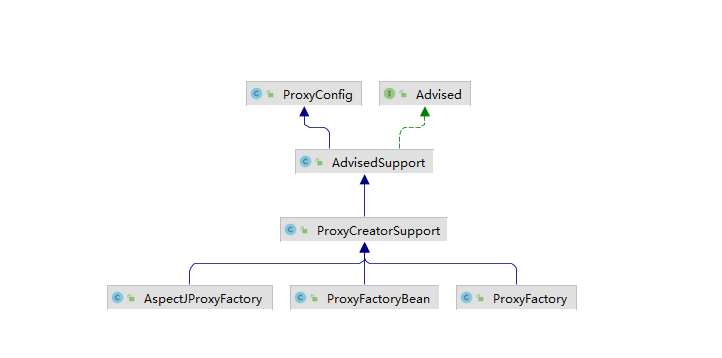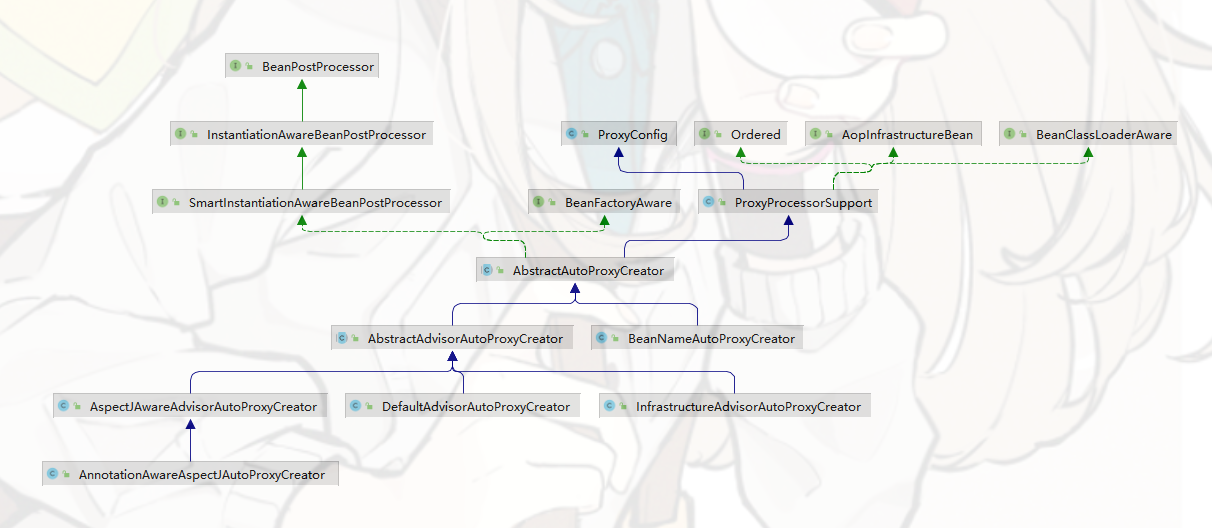Spring AOP API 粗略浏览
实在是太多了(((φ(◎ロ◎;)φ)))
AOP基础
Joinpoint
Joinpoint (see)接口描述了程序运行时的一个连接点,笼统一点就是一个方法、构造方法、字段,AOP的方法增强就是基于连接点上实现的。
1
2
3
4
5
6
7
8
9
10
11
12
13
14
15
16
17
18
19
20
21
22
23
24
25
26
27
28
29
30
31
32
public interface Joinpoint {
/**
* 执行拦截器链(Advice链)
* Proceed to the next interceptor in the chain.
* <p>The implementation and the semantics of this method depends
* on the actual joinpoint type (see the children interfaces).
* @return see the children interfaces' proceed definition
* @throws Throwable if the joinpoint throws an exception
*/
@Nullable
Object proceed() throws Throwable;
/**
* 获取当前连接点对象
* Return the object that holds the current joinpoint's static part.
* <p>For instance, the target object for an invocation.
* @return the object (can be null if the accessible object is static)
*/
@Nullable
Object getThis();
/**
* 获取当前连接点描述信息(就是Method对象)
* Return the static part of this joinpoint.
* <p>The static part is an accessible object on which a chain of
* interceptors are installed.
*/
@Nonnull
AccessibleObject getStaticPart();
}
在Spring中只有方法,主要实现类有ReflectiveMethodInvocation和CglibMethodInvocation,分别用于JDK动态代理和CGLIB动态代理。

Pointcut
Pointcut主要是用来确定哪些Joinpoint是需要切入的,主要是通过ClassFilter确认类,以及MethodMatcher匹配方法。
1
2
3
4
5
6
7
8
9
10
11
12
13
14
15
16
17
18
19
20
21
22
23
24
25
26
27
28
29
30
31
32
33
/**
* Core Spring pointcut abstraction.
*
* <p>A pointcut is composed of a {@link ClassFilter} and a {@link MethodMatcher}.
* Both these basic terms and a Pointcut itself can be combined to build up combinations
* (e.g. through {@link org.springframework.aop.support.ComposablePointcut}).
*
* @author Rod Johnson
* @see ClassFilter
* @see MethodMatcher
* @see org.springframework.aop.support.Pointcuts
* @see org.springframework.aop.support.ClassFilters
* @see org.springframework.aop.support.MethodMatchers
*/
public interface Pointcut {
/**
* Return the ClassFilter for this pointcut.
* @return the ClassFilter (never {@code null})
*/
ClassFilter getClassFilter();
/**
* Return the MethodMatcher for this pointcut.
* @return the MethodMatcher (never {@code null})
*/
MethodMatcher getMethodMatcher();
/**
* Canonical Pointcut instance that always matches.
*/
Pointcut TRUE = TruePointcut.INSTANCE;
}
具体实现有很多,比如:
StaticMethodMatcherPointcut,继承MethodMatcher,不关心运行时参数(需要匹配参数的方法默认返回true,同时final化)(@Cacheable系列注解匹配)DynamicMethodMatcherPointcut,继承DynamicMethodMatcher,可以根据运行时参数动态匹配AnnotationMatchingPointcut,注解匹配(@Async、@Validated,@Repository)ExpressionPointcut,表达式匹配(主要是AspectJ表达式,AspectJExpressionPointcut)ComposablePointcut,通过对ClassFilter、MethodMatcher各自交集、并集实现组合匹配(Pointcuts基于它实现)
Advice(Interceptor)
Advice标记接口,可以理解为是一个操作(增强、通知)。捋一捋,首先在程序运行时有很多的方法在执行(Joinpoint),而我们通过这些方法的信息筛选满足条件的方法(Pointcut),再然后在这些方法执行的时候加入一些操作(Advice)。
Advice有很多子接口以及很多的实现,接口如图:

按简单理解,大体上跟AspectJ差不多,有Around、Before、After、AfterReturn、Throws这几种不同时机的Advice,其中Around方式可以使用MethodInterceptor实现。同时Spring也整合了AspectJ上述类型的注解,如下:

其中一半是依赖MethodInterceptor,事实上除了部分Advice,其他的实现都是基于MethodInterceptor,比如异步的AsyncExecutionInterceptor、缓存的AsyncExecutionInterceptor、事务的TransactionInterceptor等。MethodInterceptor只有一个invoke方法,参数是我们的连接点MethodInvocation,可以使用Joinpoint#proceed方法执行连接点原本操作,同时也可以在它前后做操作。
PS:实际上MethodBeforeAdvice、AfterReturningAdvice、ThrowsAdvice都会通过适配器,适配为MethodInterceptor执行,所以也几乎可以将Advice与Interceptor划等号,具体看AdvisorAdapter、AdvisorAdapterRegistry。
1
2
3
4
5
6
7
8
9
10
11
12
13
14
15
16
17
18
19
20
21
22
23
24
25
26
27
28
29
30
31
32
33
34
35
36
37
38
39
40
41
/**
* Intercepts calls on an interface on its way to the target. These
* are nested "on top" of the target.
*
* <p>The user should implement the {@link #invoke(MethodInvocation)}
* method to modify the original behavior. E.g. the following class
* implements a tracing interceptor (traces all the calls on the
* intercepted method(s)):
*
* <pre class=code>
* class TracingInterceptor implements MethodInterceptor {
* Object invoke(MethodInvocation i) throws Throwable {
* System.out.println("method "+i.getMethod()+" is called on "+
* i.getThis()+" with args "+i.getArguments());
* Object ret=i.proceed();
* System.out.println("method "+i.getMethod()+" returns "+ret);
* return ret;
* }
* }
* </pre>
*
* @author Rod Johnson
*/
@FunctionalInterface
public interface MethodInterceptor extends Interceptor {
/**
//获取到连接点(方法),使我们可以在它前后做操作
* Implement this method to perform extra treatments before and
* after the invocation. Polite implementations would certainly
* like to invoke {@link Joinpoint#proceed()}.
* @param invocation the method invocation joinpoint
* @return the result of the call to {@link Joinpoint#proceed()};
* might be intercepted by the interceptorjava
* @throws Throwable if the interceptors or the target object
* throws an exception
*/
@Nullable
Object invoke(@Nonnull MethodInvocation invocation) throws Throwable;
}
Advisor
Advisor是Advice容器类,主要是用来存放Advice以及用来确定连接点是否能使用该Advice(通过Pointcut)。
1
2
3
4
5
6
7
8
9
10
11
12
13
14
15
16
17
18
19
20
21
22
23
24
25
26
27
28
29
30
/**
* Base interface holding AOP <b>advice</b> (action to take at a joinpoint)
* and a filter determining the applicability of the advice (such as
* a pointcut). <i>This interface is not for use by Spring users, but to
* allow for commonality in support for different types of advice.</i>
*
* <p>Spring AOP is based around <b>around advice</b> delivered via method
* <b>interception</b>, compliant with the AOP Alliance interception API.
* The Advisor interface allows support for different types of advice,
* such as <b>before</b> and <b>after</b> advice, which need not be
* implemented using interception.
*
* @author Rod Johnson
* @author Juergen Hoeller
*/
public interface Advisor {
......
/**
* Return the advice part of this aspect. An advice may be an
* interceptor, a before advice, a throws advice, etc.
* @return the advice that should apply if the pointcut matches
* @see org.aopalliance.intercept.MethodInterceptor
* @see BeforeAdvice
* @see ThrowsAdvice
* @see AfterReturningAdvice
*/
Advice getAdvice();
......
}
主要有两大子类型,分别是IntroductionAdvisor和PointcutAdvisor,如下。

其中IntroductionAdvisor为Introduction引入类型,主要用于为类引入新的接口功能(比如为A类引入B接口,具体要结合IntroductionInterceptor使用),具体有
DefaultIntroductionAdvisor,内置可以参考Spring的ExposeBeanNameIntroduction,它实现了NamedBean接口,使得代理对象有getBeanName的能力(可以看看DelegatingIntroductionInterceptor的invoke方法,基于是否引入接口的方法进行执行选择)DeclareParentsAdvisor,基于AspectJ的@DeclareParents
而PointcutAdvisor有很多的实现,挑几个看看
-
DefaultPointcutAdvisor默认PointcutAdvisor实现 InstantiationModelAwarePointcutAdvisor,平时使用的AspectJ注解在创建Advisor时都是使用它,唯一实现类InstantiationModelAwarePointcutAdvisorImplAbstractBeanFactoryPointcutAdvisor,主要作用是在Advice为null时,可以通过adviceBeanName从容器获取Advice,缓存(BeanFactoryCacheOperationSourceAdvisor)、事务(BeanFactoryTransactionAttributeSourceAdvisor)使用它(不过好像Advice都不为null)AsyncAnnotationAdvisor,异步相关
PS:关于IntroductionAdvisor和PointcutAdvisor有几个区别
IntroductionAdvisor只有一个ClassFilter,只能匹配到类,而PointcutAdvisor包含了Pointcut可以用于更细粒度的匹配(方法匹配)IntroductionAdvisor只能应用于Introduction类型的接口引入(其实也可以在Interceptor的invoke方法做操作,但这样违背了设计)- 最重要的一点
IntroductionAdvisor的Advice(Interceptor)需要实现引入的接口,而PointcutAdvisor中的Advice没有限制
AdvisorAdapter
AdvisorAdapter适配器,主要是将Advisor中的Advice适配为MethodInterceptor,具体看图:

1
2
3
4
5
6
7
8
9
10
11
12
13
14
class MethodBeforeAdviceAdapter implements AdvisorAdapter, Serializable {
@Override
public boolean supportsAdvice(Advice advice) {
return (advice instanceof MethodBeforeAdvice);
}
@Override
public MethodInterceptor getInterceptor(Advisor advisor) {
MethodBeforeAdvice advice = (MethodBeforeAdvice) advisor.getAdvice();
return new MethodBeforeAdviceInterceptor(advice);
}
}
AdvisorAdapterRegistry
适配器注册表,唯一实现DefaultAdvisorAdapterRegistry
1
2
3
4
5
6
7
8
9
10
11
12
13
14
15
16
17
18
19
20
21
22
23
24
25
26
27
28
29
30
31
32
33
34
35
36
37
38
39
40
41
42
43
44
45
46
47
48
49
50
51
52
53
54
55
56
57
58
59
60
61
62
63
64
65
66
public class DefaultAdvisorAdapterRegistry implements AdvisorAdapterRegistry, Serializable {
private final List<AdvisorAdapter> adapters = new ArrayList<>(3);
/**
* Create a new DefaultAdvisorAdapterRegistry, registering well-known adapters.
*/
public DefaultAdvisorAdapterRegistry() {
//将MethodBeforeAdvice、AfterReturningAdvice、ThrowsAdvice的适配器注册
registerAdvisorAdapter(new MethodBeforeAdviceAdapter());
registerAdvisorAdapter(new AfterReturningAdviceAdapter());
registerAdvisorAdapter(new ThrowsAdviceAdapter());
}
//对Advice进行包装,包装为DefaultPointcutAdvisor
@Override
public Advisor wrap(Object adviceObject) throws UnknownAdviceTypeException {
if (adviceObject instanceof Advisor) {
return (Advisor) adviceObject;
}
if (!(adviceObject instanceof Advice)) {
throw new UnknownAdviceTypeException(adviceObject);
}
Advice advice = (Advice) adviceObject;
if (advice instanceof MethodInterceptor) {
// So well-known it doesn't even need an adapter.
return new DefaultPointcutAdvisor(advice);
}
for (AdvisorAdapter adapter : this.adapters) {
//将MethodBeforeAdvice、AfterReturningAdvice、ThrowsAdvice包装为DefaultPointcutAdvisor
// Check that it is supported.
if (adapter.supportsAdvice(advice)) {
return new DefaultPointcutAdvisor(advice);
}
}
throw new UnknownAdviceTypeException(advice);
}
//将Advisor中的Advice统一转换为MethodInterceptor
@Override
public MethodInterceptor[] getInterceptors(Advisor advisor) throws UnknownAdviceTypeException {
List<MethodInterceptor> interceptors = new ArrayList<>(3);
Advice advice = advisor.getAdvice();
if (advice instanceof MethodInterceptor) {
interceptors.add((MethodInterceptor) advice);
}
for (AdvisorAdapter adapter : this.adapters) {
//将MethodBeforeAdvice、AfterReturningAdvice、ThrowsAdvice适配为对应的MethodInterceptor
if (adapter.supportsAdvice(advice)) {
interceptors.add(adapter.getInterceptor(advisor));
}
}
if (interceptors.isEmpty()) {
throw new UnknownAdviceTypeException(advisor.getAdvice());
}
return interceptors.toArray(new MethodInterceptor[0]);
}
@Override
public void registerAdvisorAdapter(AdvisorAdapter adapter) {
this.adapters.add(adapter);
}
}
代理相关
代理对象

AopProxy
代理对象抽象接口,提供了获取代理对象的方法getProxy和getProxy(ClassLoader classLoader),具体实现有JDK和CGLIB的实现。
1
2
3
4
5
6
7
8
9
10
11
12
13
14
15
16
17
18
19
20
21
22
23
24
public interface AopProxy {
/**
* Create a new proxy object.
* <p>Uses the AopProxy's default class loader (if necessary for proxy creation):
* usually, the thread context class loader.
* @return the new proxy object (never {@code null})
* @see Thread#getContextClassLoader()
*/
Object getProxy();
/**
* Create a new proxy object.
* <p>Uses the given class loader (if necessary for proxy creation).
* {@code null} will simply be passed down and thus lead to the low-level
* proxy facility's default, which is usually different from the default chosen
* by the AopProxy implementation's {@link #getProxy()} method.
* @param classLoader the class loader to create the proxy with
* (or {@code null} for the low-level proxy facility's default)
* @return the new proxy object (never {@code null})
*/
Object getProxy(@Nullable ClassLoader classLoader);
}
代理对象工厂
AopProxyFactory
代理工厂能根据代理配置AdvisedSupport生成代理对象AopProxy,同时生成的对象要符合一系列规定(看注释)。
1
2
3
4
5
6
7
8
9
10
11
12
13
14
15
16
17
18
19
20
21
22
23
24
25
26
27
28
29
30
31
32
33
34
35
36
37
/**
* Interface to be implemented by factories that are able to create
* AOP proxies based on {@link AdvisedSupport} configuration objects.
*
* <p>Proxies should observe the following contract:
* <ul>
* <li>They should implement all interfaces that the configuration
* indicates should be proxied.
* <li>They should implement the {@link Advised} interface.
* <li>They should implement the equals method to compare proxied
* interfaces, advice, and target.
* <li>They should be serializable if all advisors and target
* are serializable.
* <li>They should be thread-safe if advisors and target
* are thread-safe.
* </ul>
*
* <p>Proxies may or may not allow advice changes to be made.
* If they do not permit advice changes (for example, because
* the configuration was frozen) a proxy should throw an
* {@link AopConfigException} on an attempted advice change.
*
* @author Rod Johnson
* @author Juergen Hoeller
*/
public interface AopProxyFactory {
/**
* Create an {@link AopProxy} for the given AOP configuration.
* @param config the AOP configuration in the form of an
* AdvisedSupport object
* @return the corresponding AOP proxy
* @throws AopConfigException if the configuration is invalid
*/
AopProxy createAopProxy(AdvisedSupport config) throws AopConfigException;
}
DefaultAopProxyFactory
代理工厂默认实现,根据配置选择生成JDK还是CGLIB的代理对象。
1
2
3
4
5
6
7
8
9
10
11
12
13
14
15
16
17
18
19
20
21
22
23
24
25
26
27
28
29
30
31
32
33
34
public class DefaultAopProxyFactory implements AopProxyFactory, Serializable {
@Override
public AopProxy createAopProxy(AdvisedSupport config) throws AopConfigException {
//判断是否GraalVM镜像环境是的话只能用jdk动态代理,否则根据是否优化,是否配置直接代理目标类,是否无接口或者是否只使用SpringProxy接口选择CGLIB
if (!NativeDetector.inNativeImage() &&
(config.isOptimize() || config.isProxyTargetClass() || hasNoUserSuppliedProxyInterfaces(config))) {
Class<?> targetClass = config.getTargetClass();
if (targetClass == null) {
throw new AopConfigException("TargetSource cannot determine target class: " +
"Either an interface or a target is required for proxy creation.");
}
if (targetClass.isInterface() || Proxy.isProxyClass(targetClass)) {
return new JdkDynamicAopProxy(config);
}
return new ObjenesisCglibAopProxy(config);
}
else {
return new JdkDynamicAopProxy(config);
}
}
/**
* Determine whether the supplied {@link AdvisedSupport} has only the
* {@link org.springframework.aop.SpringProxy} interface specified
* (or no proxy interfaces specified at all).
*/
private boolean hasNoUserSuppliedProxyInterfaces(AdvisedSupport config) {
Class<?>[] ifcs = config.getProxiedInterfaces();
return (ifcs.length == 0 || (ifcs.length == 1 && SpringProxy.class.isAssignableFrom(ifcs[0])));
}
}
代理配置
Advised
Advised是AOP 代理配置管理接口,通过它可以实现Advisor、Advice的增删,以及代理类型的获取等配置,主要由代理工厂实现;同时Spring AOP生成的代理对象都可以转换为Advised接口类型(具体在生成代理对象时通过AopProxyUtils#completeProxiedInterfaces获取代理接口时加入的)。
关于Advised、Advisor以及Advice:
Advice代表一个操作(通知、增强),即切面织入的新功能Advisor是Advice的容器类,可以获取Advice以及Advice是否适用的过滤器(Pointcut、ClassFilter)Advised代表已经被代理的对象,包含了多个Advisor(一个代理对象可以被多次增强)
ProxyConfig
ProxyConfig代理配置的基类,主要是为了确保代理创建者属性的一致
1
2
3
4
5
6
7
8
9
10
11
12
13
14
15
16
17
18
19
20
21
22
23
/**
* Convenience superclass for configuration used in creating proxies,
* to ensure that all proxy creators have consistent properties.
*
*/
public class ProxyConfig implements Serializable {
......
//确认代理的类型,是否代理目标类(CGLIB)
private boolean proxyTargetClass = false;
//代理是否积极的优化,此属性影响代理类型的选择(Spring折衷的认为CGLIB是一种优化),为true时有可能使用CGLIB代理,无论是否有实现接口
private boolean optimize = false;
//是否不透明,代理配置信息是否不公开,具体作用是是否将Advised接口接入加入代理对象接口列表中中,默认为false,即Spring AOP生成的代理对象都可以转换为Advised接口类型
boolean opaque = false;
//是否暴露代理对象,具体在AopContext获取当前代理对象应用中
boolean exposeProxy = false;
//是否被冻结,主要用来控制Advisor等配置的修改,true时不允许修改
private boolean frozen = false;
......
}
AdvisedSupport
AdvisedSupport继承了Advised和ProxyConfig,主要提供代理配置的能力,它的子类都是代理工厂,另外AdvisedSupport还提供方法适配的Advisor缓存等能力(AdvisorChainFactory),Advised类关系如图:

代理对象创建
ProxyCreatorSupport
代理工厂的父类,继承AdvisedSupport,因此有配置的功能,组合AopProxyFactory结合自身配置实现创建代理抽象类AopProxy的能力。
1
2
3
4
5
6
7
8
9
10
11
12
13
14
15
16
17
18
19
20
21
22
23
24
25
26
27
public class ProxyCreatorSupport extends AdvisedSupport {
private AopProxyFactory aopProxyFactory;
......
/**
* Return the AopProxyFactory that this ProxyConfig uses.
*/
public AopProxyFactory getAopProxyFactory() {
return this.aopProxyFactory;
}
......
/**
* Subclasses should call this to get a new AOP proxy. They should <b>not</b>
* create an AOP proxy with {@code this} as an argument.
*/
protected final synchronized AopProxy createAopProxy() {
if (!this.active) {
activate();
}
return getAopProxyFactory().createAopProxy(this);
}
......
}
API编程创建
ProxyFactory
默认实现,基于编程式的方法创建代理对象。
ProxyFactoryBean
实现了FactoryBean接口,提供了基于FactoryBean构建代理对象的能力。可以通过将ProxyFactoryBean注入到IoC容器,setTargetName配置Bean的名称获取对应的代理(或者setTargetSource)。
AspectJProxyFactory
跟ProxyFactory类似,但是提供直接指定代理对象需要绑定的切面类的能力(addAspect方法绑定切面)
自动创建
AbstractAutoProxyCreator
在Spring 容器中,主要是通过AbstractAutoProxyCreator实现Bean的代理自动创建,具体为实现SmartInstantiationAwareBeanPostProcessor在Bean的生命周期中(实例化前或初始化后),使用容器中注册的Advisor,根据ProxyFactory创建代理对象,同时本身通过ProxyProcessorSupport也继承了ProxyConfig,具有代理配置的功能。
1
2
3
4
5
6
7
8
9
10
11
12
13
14
15
16
17
18
19
20
21
22
23
24
25
26
27
28
29
30
31
32
33
34
35
36
37
38
39
40
41
42
43
44
45
46
47
48
49
50
51
52
53
54
55
56
57
58
59
60
61
62
63
64
65
66
67
68
69
70
71
72
73
74
75
76
77
78
79
80
81
82
83
84
85
86
87
88
89
90
91
92
93
94
95
96
97
98
99
100
101
102
103
104
105
106
107
108
109
110
111
112
113
114
115
116
117
118
119
120
121
122
123
124
125
126
127
128
129
130
131
132
133
134
135
136
137
138
139
140
141
142
143
144
145
146
147
148
149
150
151
152
153
154
155
156
157
158
159
160
161
162
163
164
165
166
167
168
169
170
171
172
173
174
175
176
177
178
179
180
181
182
183
184
185
186
187
188
189
190
191
192
193
194
195
196
197
198
199
200
201
202
203
204
205
206
207
208
209
210
211
212
213
214
215
216
217
public abstract class AbstractAutoProxyCreator extends ProxyProcessorSupport
implements SmartInstantiationAwareBeanPostProcessor, BeanFactoryAware {
......
//实例化前有可能直接创建为代理
@Override
public Object postProcessBeforeInstantiation(Class<?> beanClass, String beanName) {
Object cacheKey = getCacheKey(beanClass, beanName);
if (!StringUtils.hasLength(beanName) || !this.targetSourcedBeans.contains(beanName)) {
if (this.advisedBeans.containsKey(cacheKey)) {
return null;
}
if (isInfrastructureClass(beanClass) || shouldSkip(beanClass, beanName)) {
this.advisedBeans.put(cacheKey, Boolean.FALSE);
return null;
}
}
// Create proxy here if we have a custom TargetSource.
// Suppresses unnecessary default instantiation of the target bean:
// The TargetSource will handle target instances in a custom fashion.
TargetSource targetSource = getCustomTargetSource(beanClass, beanName);
if (targetSource != null) {
if (StringUtils.hasLength(beanName)) {
this.targetSourcedBeans.add(beanName);
}
//根据当前Bean获取容器中适用的Advices、Advisors
Object[] specificInterceptors = getAdvicesAndAdvisorsForBean(beanClass, beanName, targetSource);
Object proxy = createProxy(beanClass, beanName, specificInterceptors, targetSource);
this.proxyTypes.put(cacheKey, proxy.getClass());
return proxy;
}
return null;
}
......
//初始化后也有可能创建代理
/**
* Create a proxy with the configured interceptors if the bean is
* identified as one to proxy by the subclass.
* @see #getAdvicesAndAdvisorsForBean
*/
@Override
public Object postProcessAfterInitialization(@Nullable Object bean, String beanName) {
if (bean != null) {
Object cacheKey = getCacheKey(bean.getClass(), beanName);
if (this.earlyProxyReferences.remove(cacheKey) != bean) {
return wrapIfNecessary(bean, beanName, cacheKey);
}
}
return bean;
}
.....
/**
* Wrap the given bean if necessary, i.e. if it is eligible for being proxied.
* @param bean the raw bean instance
* @param beanName the name of the bean
* @param cacheKey the cache key for metadata access
* @return a proxy wrapping the bean, or the raw bean instance as-is
*/
protected Object wrapIfNecessary(Object bean, String beanName, Object cacheKey) {
if (StringUtils.hasLength(beanName) && this.targetSourcedBeans.contains(beanName)) {
return bean;
}
if (Boolean.FALSE.equals(this.advisedBeans.get(cacheKey))) {
return bean;
}
if (isInfrastructureClass(bean.getClass()) || shouldSkip(bean.getClass(), beanName)) {
this.advisedBeans.put(cacheKey, Boolean.FALSE);
return bean;
}
// Create proxy if we have advice.
//根据当前Bean获取容器中适用的Advices、Advisors
Object[] specificInterceptors = getAdvicesAndAdvisorsForBean(bean.getClass(), beanName, null);
if (specificInterceptors != DO_NOT_PROXY) {
this.advisedBeans.put(cacheKey, Boolean.TRUE);
Object proxy = createProxy(
bean.getClass(), beanName, specificInterceptors, new SingletonTargetSource(bean));
this.proxyTypes.put(cacheKey, proxy.getClass());
return proxy;
}
this.advisedBeans.put(cacheKey, Boolean.FALSE);
return bean;
}
......
/**
* Create an AOP proxy for the given bean.
* @param beanClass the class of the bean
* @param beanName the name of the bean
* @param specificInterceptors the set of interceptors that is
* specific to this bean (may be empty, but not null)
* @param targetSource the TargetSource for the proxy,
* already pre-configured to access the bean
* @return the AOP proxy for the bean
* @see #buildAdvisors
*/
protected Object createProxy(Class<?> beanClass, @Nullable String beanName,
@Nullable Object[] specificInterceptors, TargetSource targetSource) {
if (this.beanFactory instanceof ConfigurableListableBeanFactory) {
AutoProxyUtils.exposeTargetClass((ConfigurableListableBeanFactory) this.beanFactory, beanName, beanClass);
}
//创建ProxyFactory,并配置
ProxyFactory proxyFactory = new ProxyFactory();
proxyFactory.copyFrom(this);
if (proxyFactory.isProxyTargetClass()) {
// Explicit handling of JDK proxy targets (for introduction advice scenarios)
if (Proxy.isProxyClass(beanClass)) {
// Must allow for introductions; can't just set interfaces to the proxy's interfaces only.
for (Class<?> ifc : beanClass.getInterfaces()) {
proxyFactory.addInterface(ifc);
}
}
}
else {
// No proxyTargetClass flag enforced, let's apply our default checks...
if (shouldProxyTargetClass(beanClass, beanName)) {
proxyFactory.setProxyTargetClass(true);
}
else {
evaluateProxyInterfaces(beanClass, proxyFactory);
}
}
//将获取到的Advices、Advisors统一成Advisor
Advisor[] advisors = buildAdvisors(beanName, specificInterceptors);
proxyFactory.addAdvisors(advisors);
proxyFactory.setTargetSource(targetSource);
customizeProxyFactory(proxyFactory);
proxyFactory.setFrozen(this.freezeProxy);
if (advisorsPreFiltered()) {
proxyFactory.setPreFiltered(true);
}
// Use original ClassLoader if bean class not locally loaded in overriding class loader
ClassLoader classLoader = getProxyClassLoader();
if (classLoader instanceof SmartClassLoader && classLoader != beanClass.getClassLoader()) {
classLoader = ((SmartClassLoader) classLoader).getOriginalClassLoader();
}
//使用proxyFactory创建代理对象
return proxyFactory.getProxy(classLoader);
}
......
/**
* Determine the advisors for the given bean, including the specific interceptors
* as well as the common interceptor, all adapted to the Advisor interface.
* @param beanName the name of the bean
* @param specificInterceptors the set of interceptors that is
* specific to this bean (may be empty, but not null)
* @return the list of Advisors for the given bean
*/
protected Advisor[] buildAdvisors(@Nullable String beanName, @Nullable Object[] specificInterceptors) {
// Handle prototypes correctly...
//获取容器中的通用的Advisor,默认没有
Advisor[] commonInterceptors = resolveInterceptorNames();
List<Object> allInterceptors = new ArrayList<>();
if (specificInterceptors != null) {
if (specificInterceptors.length > 0) {
// specificInterceptors may equal PROXY_WITHOUT_ADDITIONAL_INTERCEPTORS
allInterceptors.addAll(Arrays.asList(specificInterceptors));
}
if (commonInterceptors.length > 0) {
if (this.applyCommonInterceptorsFirst) {
allInterceptors.addAll(0, Arrays.asList(commonInterceptors));
}
else {
allInterceptors.addAll(Arrays.asList(commonInterceptors));
}
}
}
if (logger.isTraceEnabled()) {
int nrOfCommonInterceptors = commonInterceptors.length;
int nrOfSpecificInterceptors = (specificInterceptors != null ? specificInterceptors.length : 0);
logger.trace("Creating implicit proxy for bean '" + beanName + "' with " + nrOfCommonInterceptors +
" common interceptors and " + nrOfSpecificInterceptors + " specific interceptors");
}
Advisor[] advisors = new Advisor[allInterceptors.size()];
for (int i = 0; i < allInterceptors.size(); i++) {
//通过advisorAdapterRegistry对Advice进行适配,最终包装成DefaultPointcutAdvisor
advisors[i] = this.advisorAdapterRegistry.wrap(allInterceptors.get(i));
}
return advisors;
}
/**
* Resolves the specified interceptor names to Advisor objects.
* @see #setInterceptorNames
*/
private Advisor[] resolveInterceptorNames() {
BeanFactory bf = this.beanFactory;
ConfigurableBeanFactory cbf = (bf instanceof ConfigurableBeanFactory ? (ConfigurableBeanFactory) bf : null);
List<Advisor> advisors = new ArrayList<>();
for (String beanName : this.interceptorNames) {
if (cbf == null || !cbf.isCurrentlyInCreation(beanName)) {
Assert.state(bf != null, "BeanFactory required for resolving interceptor names");
Object next = bf.getBean(beanName);
advisors.add(this.advisorAdapterRegistry.wrap(next));
}
}
return advisors.toArray(new Advisor[0]);
}
......
}
主要类图如下:

DefaultAdvisorAutoProxyCreator
默认实现,根据容器中注册的Advisor创建代理,可以配置Advisor的BeanName前缀匹配
BeanNameAutoProxyCreator
根据配置的BeanNames(或者匹配规则)判断Bean是否需要被代理。
AnnotationAwareAspectJAutoProxyCreator
@Aspect注解的代理自动创建
InfrastructureAdvisorAutoProxyCreator
过滤用户自定义Advisor,只考虑Spring内部的Advisor的代理自动创建器(比如事务、缓存的AOP)。
PS:判断方法为BeanDefinition#getRole是否等于BeanDefinition#ROLE_INFRASTRUCTURE。
补充
TargetSource
TargetSource目标源是对被代理对象的封装,Spring的代理的对象实际上都是TargetSource,在进行代理前,会使用TargetSource对目标进行包装。
1
2
3
4
5
6
7
8
9
10
11
12
13
14
15
16
17
18
19
20
21
22
23
24
25
26
27
28
29
30
31
32
33
34
35
36
37
38
39
40
public interface TargetSource extends TargetClassAware {
/**
* Return the type of targets returned by this {@link TargetSource}.
* <p>Can return {@code null}, although certain usages of a {@code TargetSource}
* might just work with a predetermined target class.
* @return the type of targets returned by this {@link TargetSource}
*/
@Override
@Nullable
Class<?> getTargetClass();
/**
* Will all calls to {@link #getTarget()} return the same object?
* <p>In that case, there will be no need to invoke {@link #releaseTarget(Object)},
* and the AOP framework can cache the return value of {@link #getTarget()}.
* @return {@code true} if the target is immutable
* @see #getTarget
*/
boolean isStatic();
/**
* Return a target instance. Invoked immediately before the
* AOP framework calls the "target" of an AOP method invocation.
* @return the target object which contains the joinpoint,
* or {@code null} if there is no actual target instance
* @throws Exception if the target object can't be resolved
*/
@Nullable
Object getTarget() throws Exception;
/**
* Release the given target object obtained from the
* {@link #getTarget()} method, if any.
* @param target object obtained from a call to {@link #getTarget()}
* @throws Exception if the object can't be released
*/
void releaseTarget(Object target) throws Exception;
}
有很多的实现,最主要就是SingletonTargetSource
SingletonTargetSource,默认的TargetSourceLazyInitTargetSource,针对懒加载BeanJndiObjectTargetSource,针对JNDIThreadLocalTargetSource,线程隔离的- ……太多了
AdvisorChainFactory
Advisor链工厂,提供根据方法筛选所有适用的Advisor的能力,只有DefaultAdvisorChainFactory一个实现,在AdvisedSupport#getInterceptorsAndDynamicInterceptionAdvice方法中使用,在AopProxy代理执行时,会根据此方法获取适配的Advisor链进行方法的增强,同时AdvisedSupport会把相应方法的Advisors进行缓存。
1
2
3
4
5
6
7
8
9
10
11
12
13
14
public interface AdvisorChainFactory {
/**
* Determine a list of {@link org.aopalliance.intercept.MethodInterceptor} objects
* for the given advisor chain configuration.
* @param config the AOP configuration in the form of an Advised object
* @param method the proxied method
* @param targetClass the target class (may be {@code null} to indicate a proxy without
* target object, in which case the method's declaring class is the next best option)
* @return a List of MethodInterceptors (may also include IjavanterceptorAndDynamicMethodMatchers)
*/
List<Object> getInterceptorsAndDynamicInterceptionAdvice(Advised config, Method method, @Nullable Class<?> targetClass);
}
AopUtils
提供查询适用的Advisor、执行代理方法等支持
